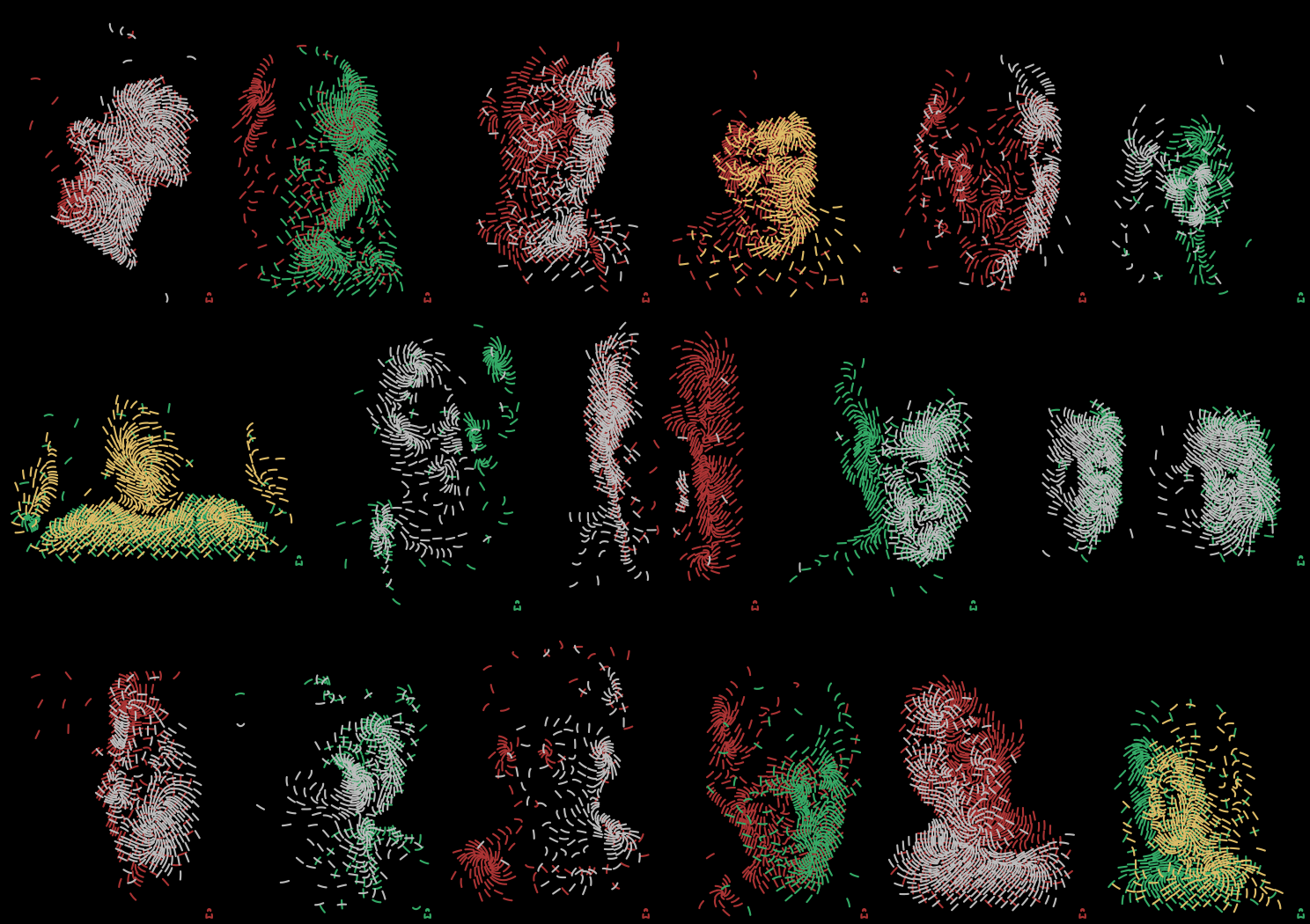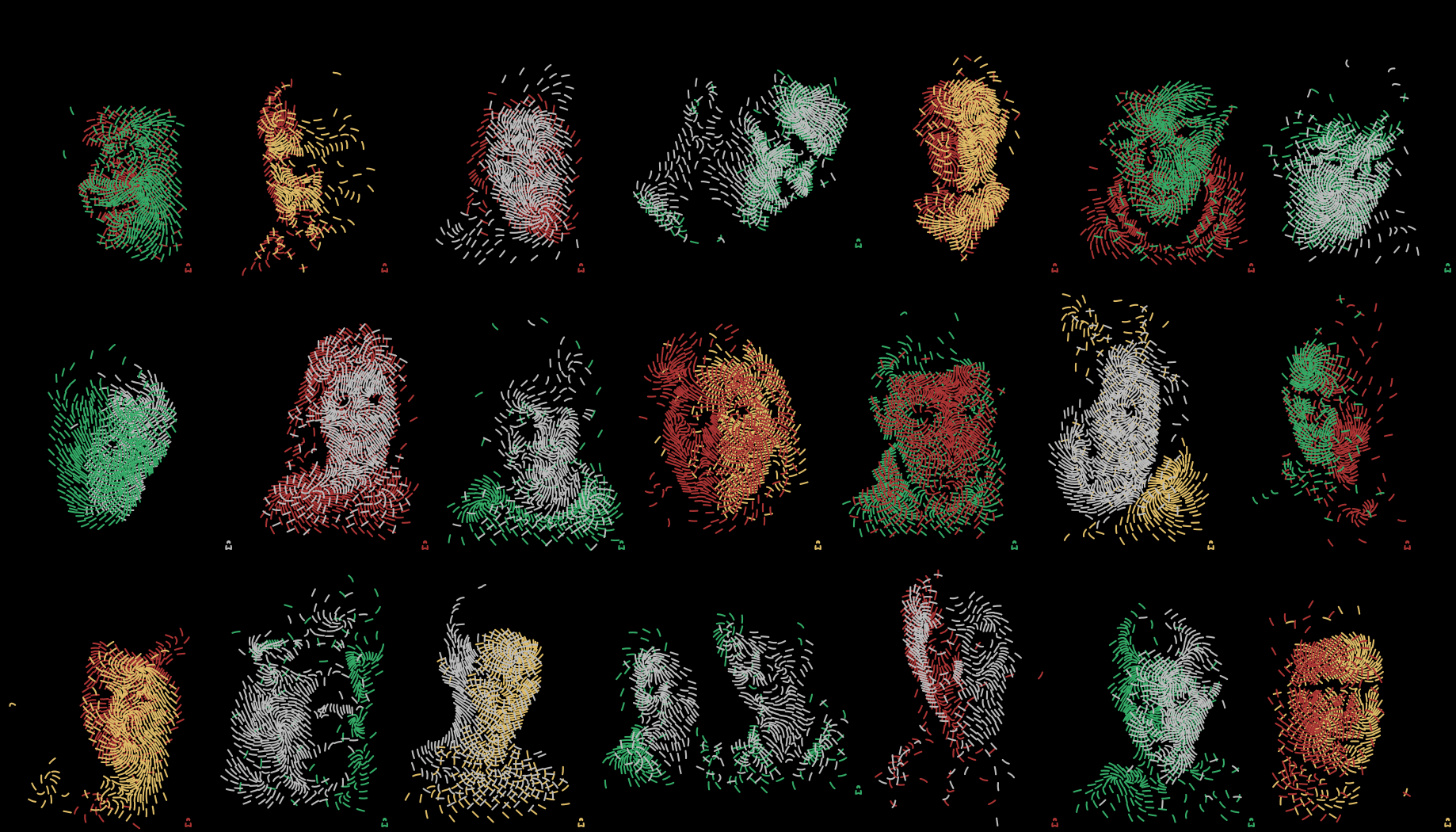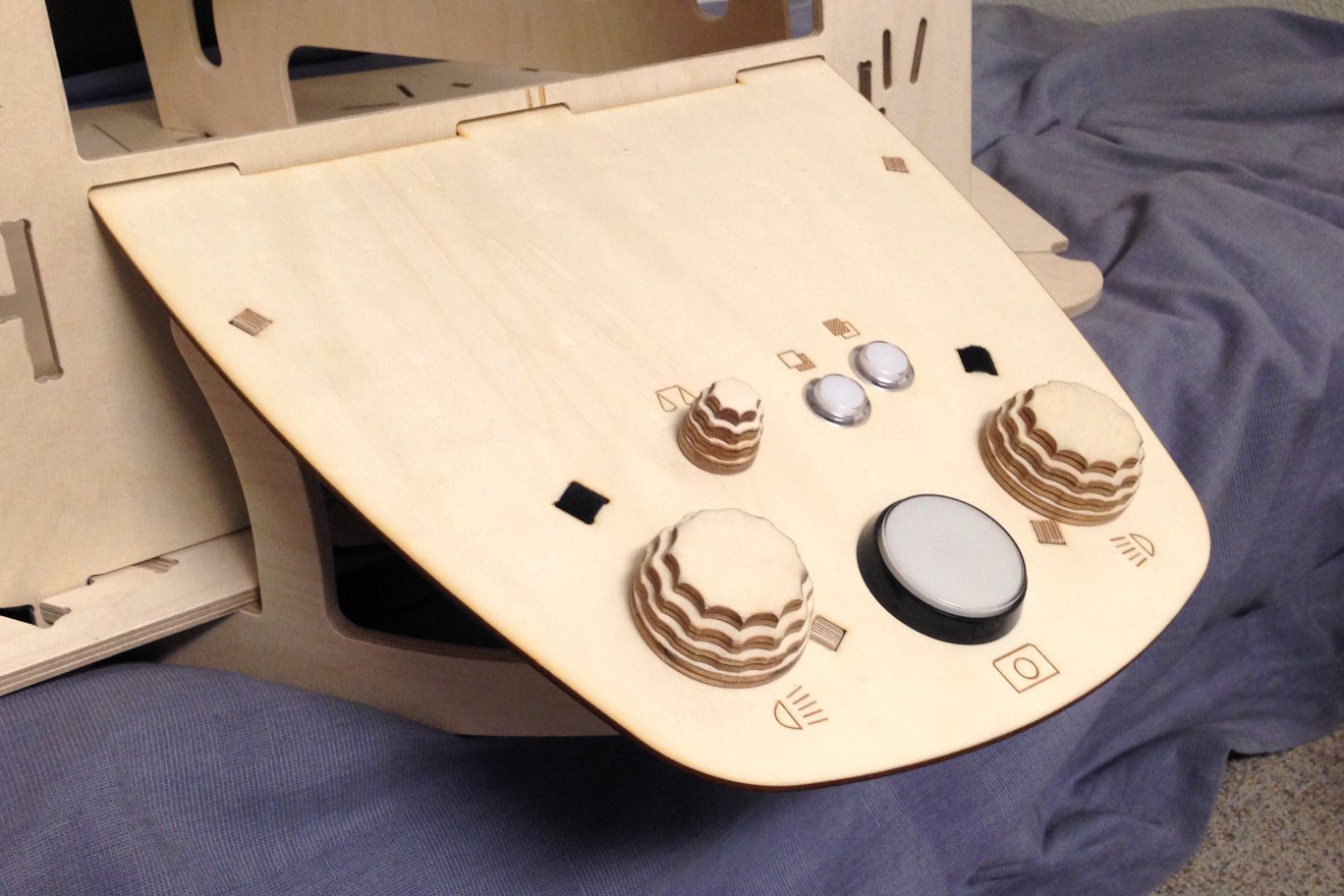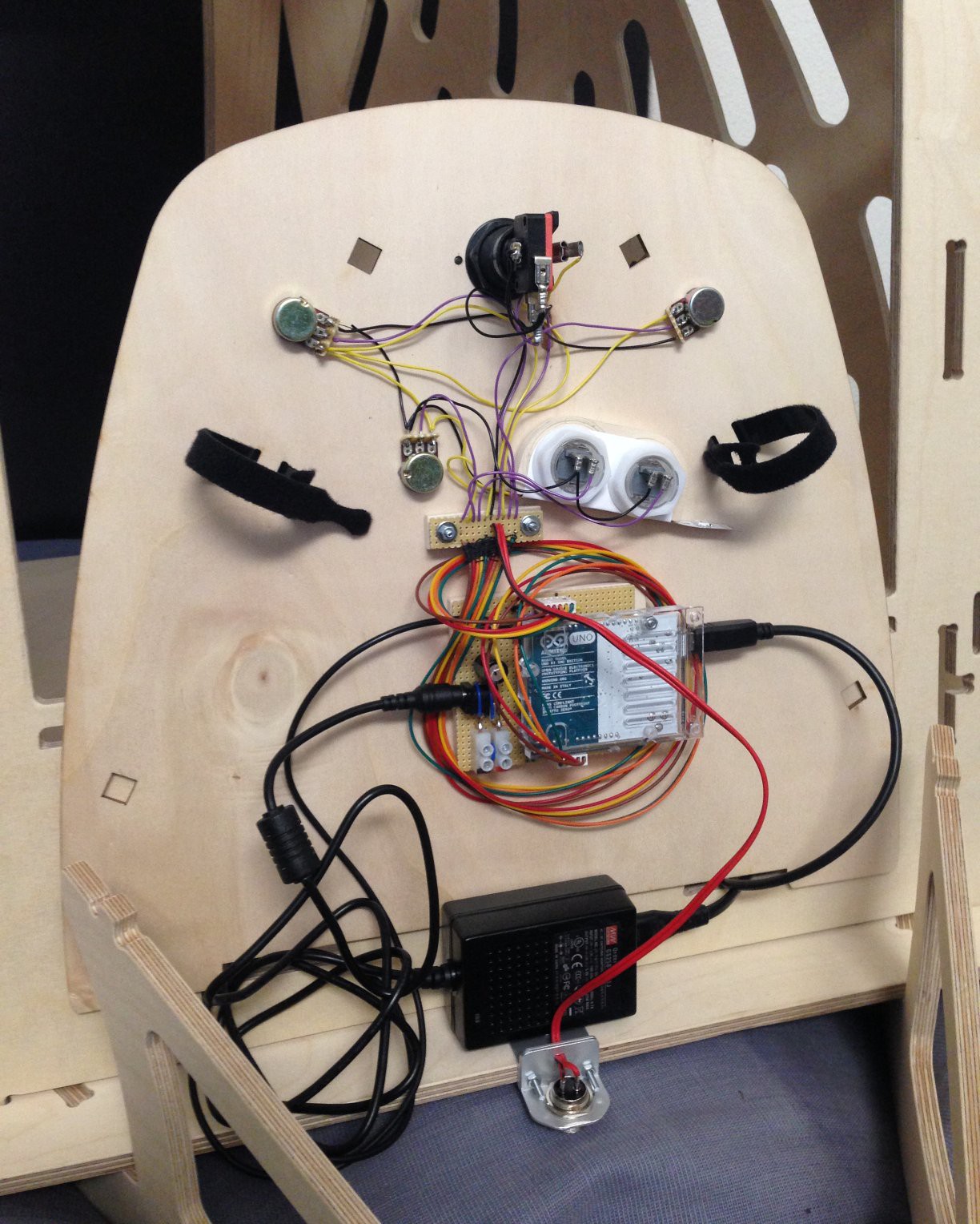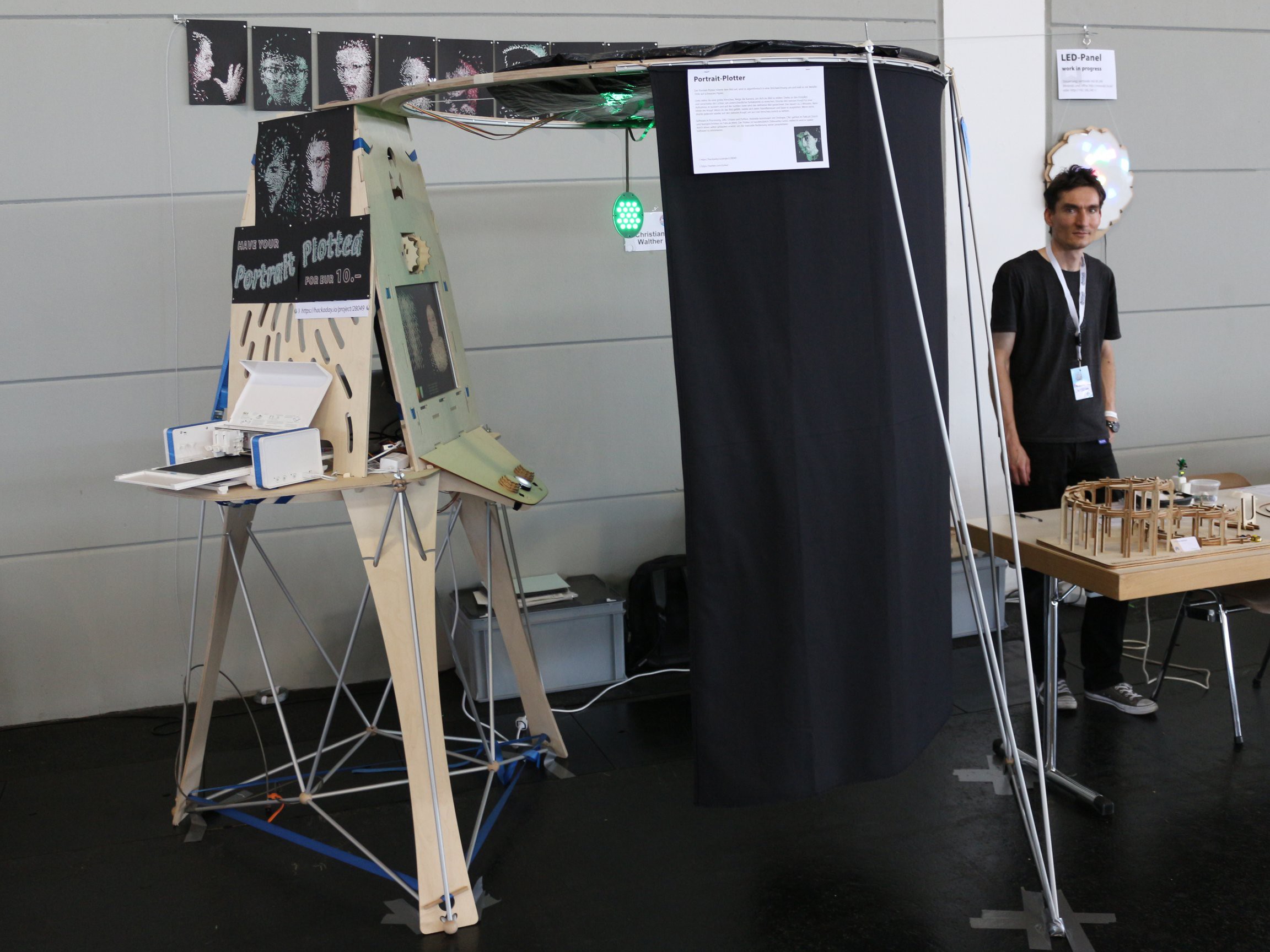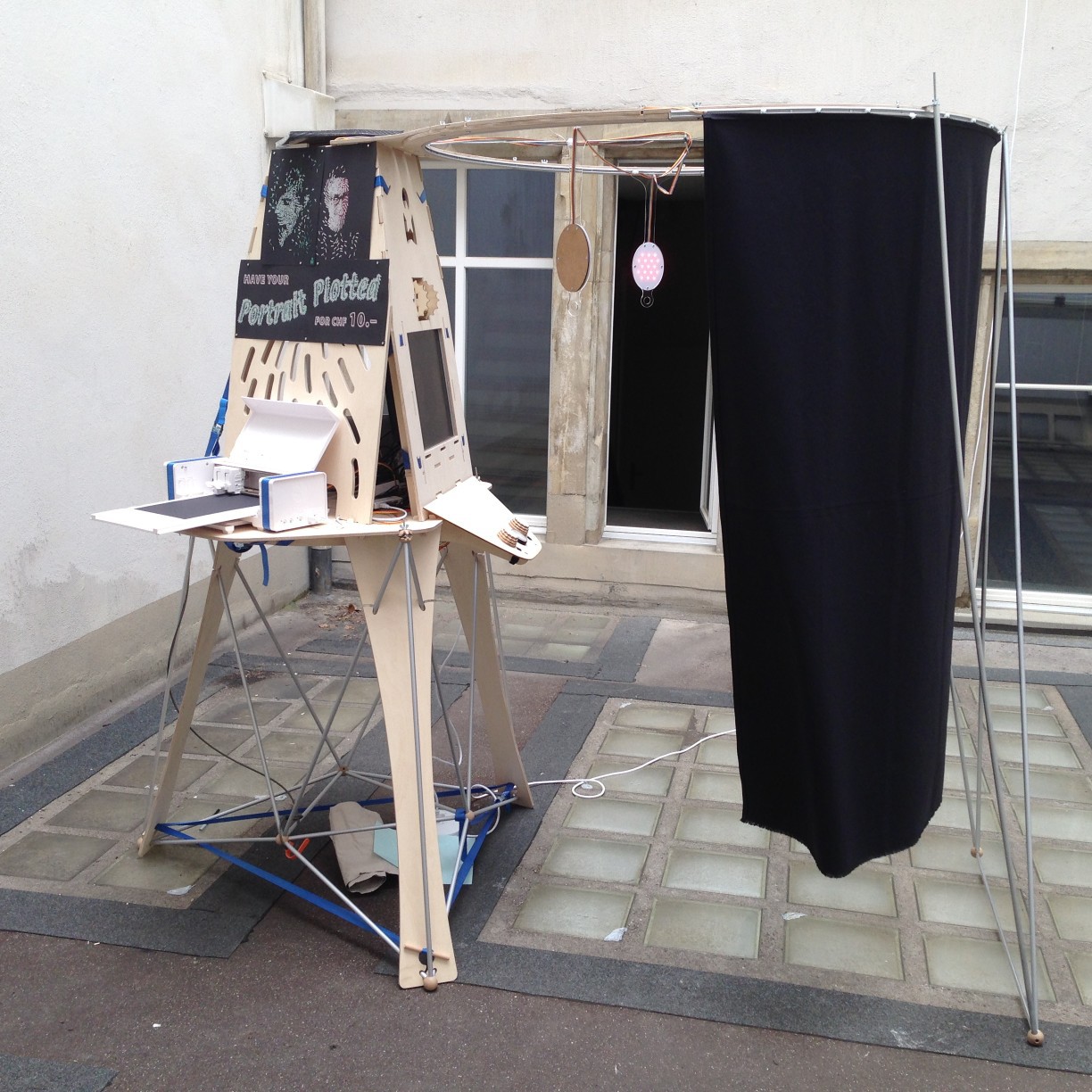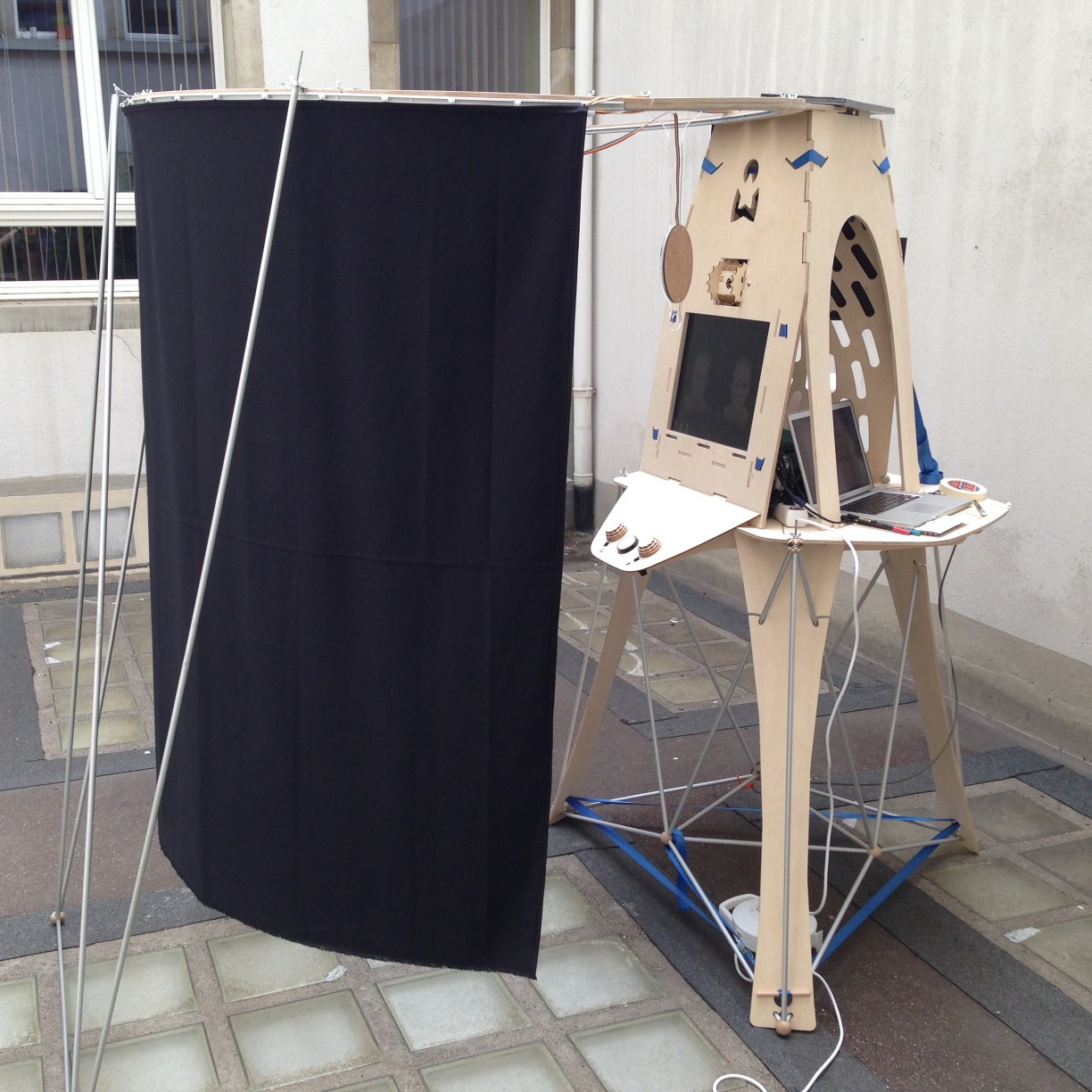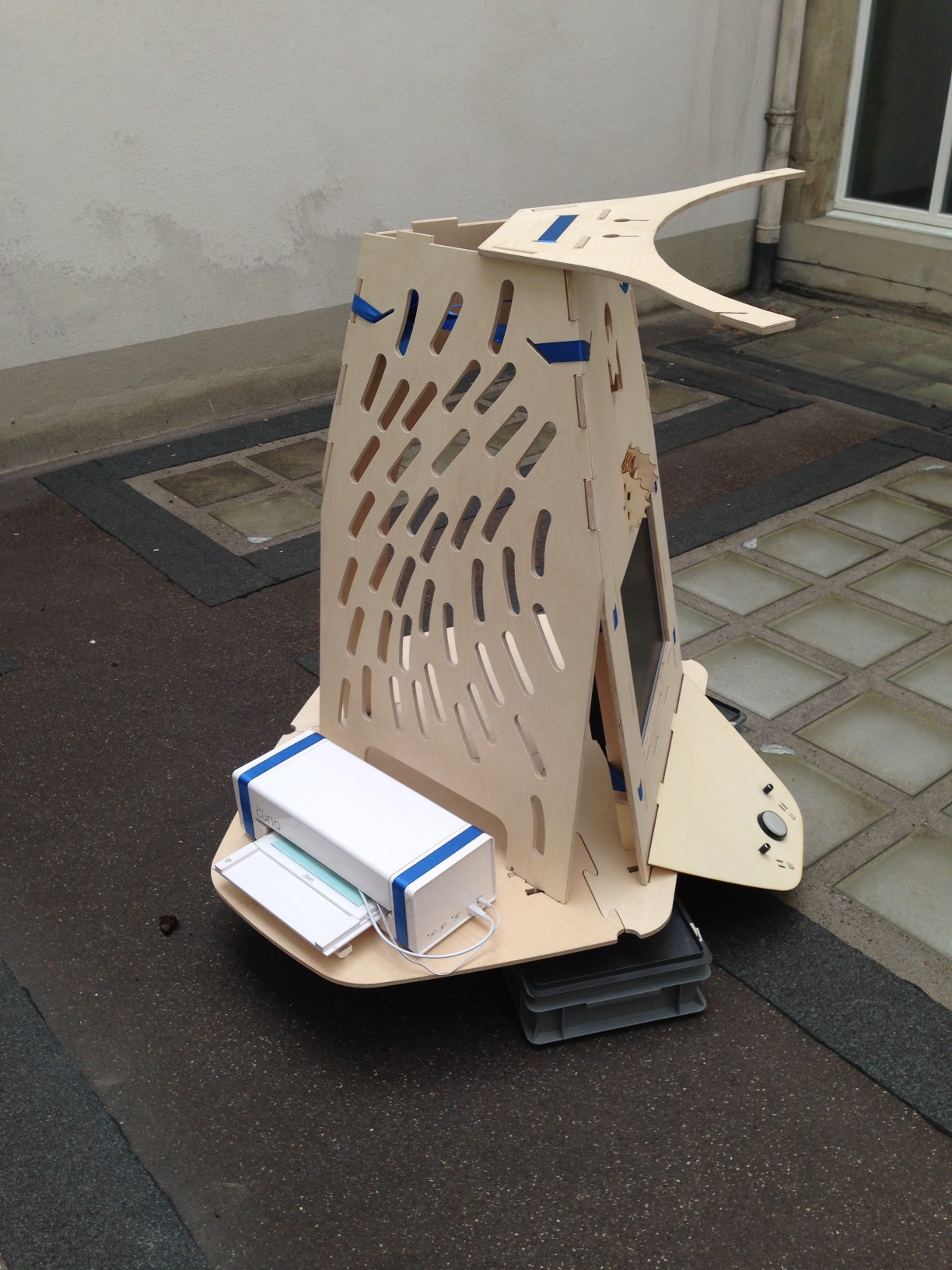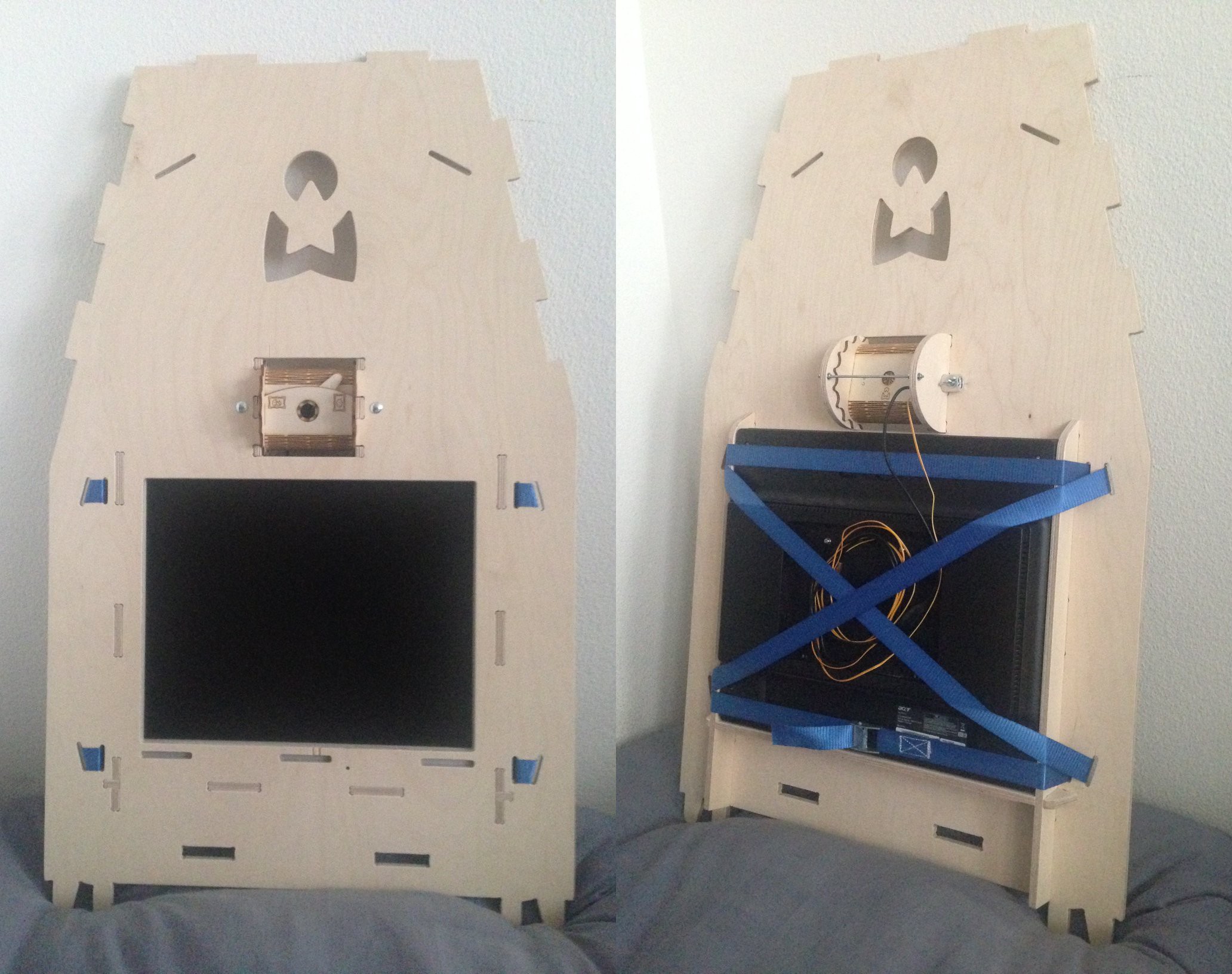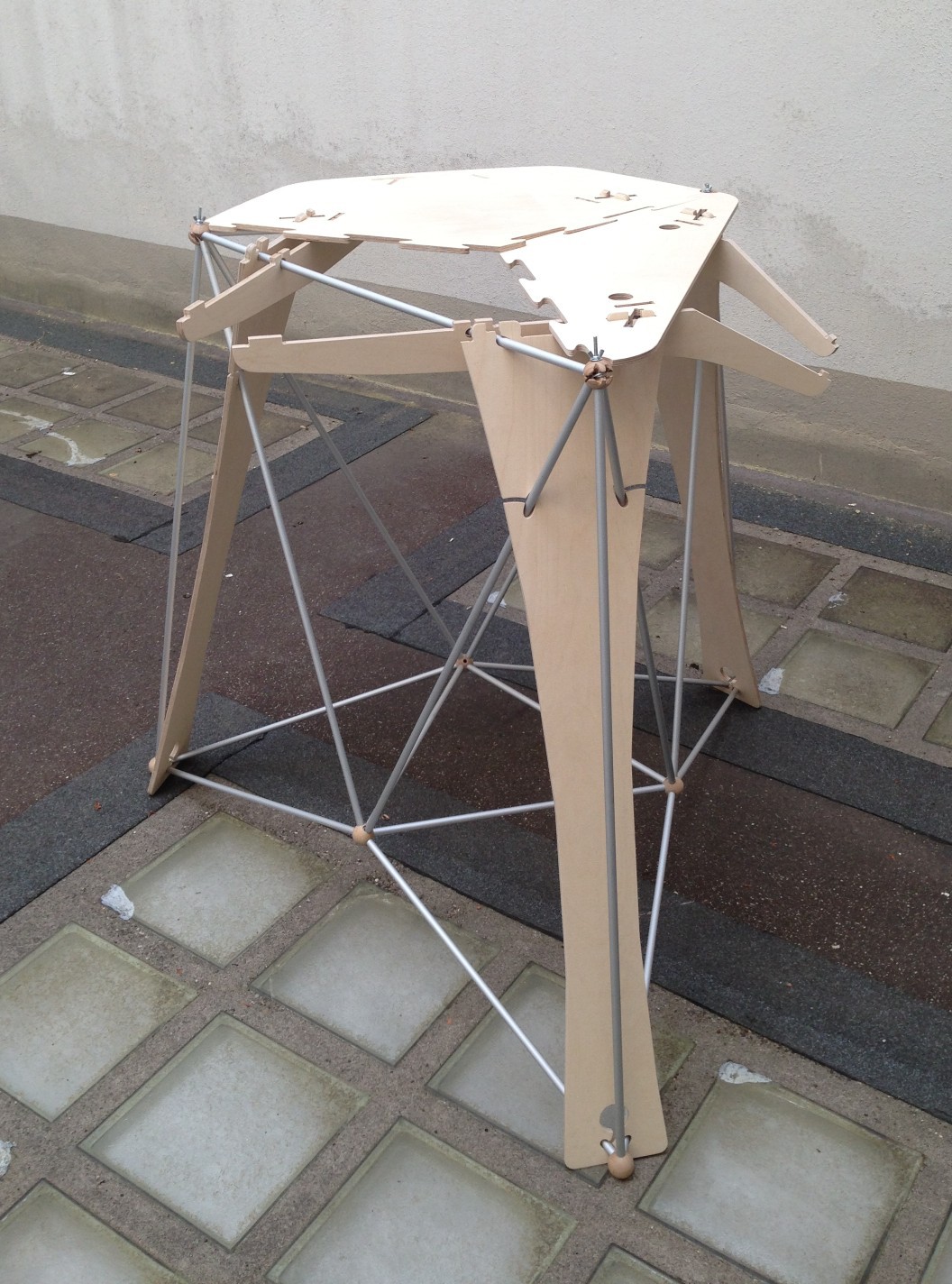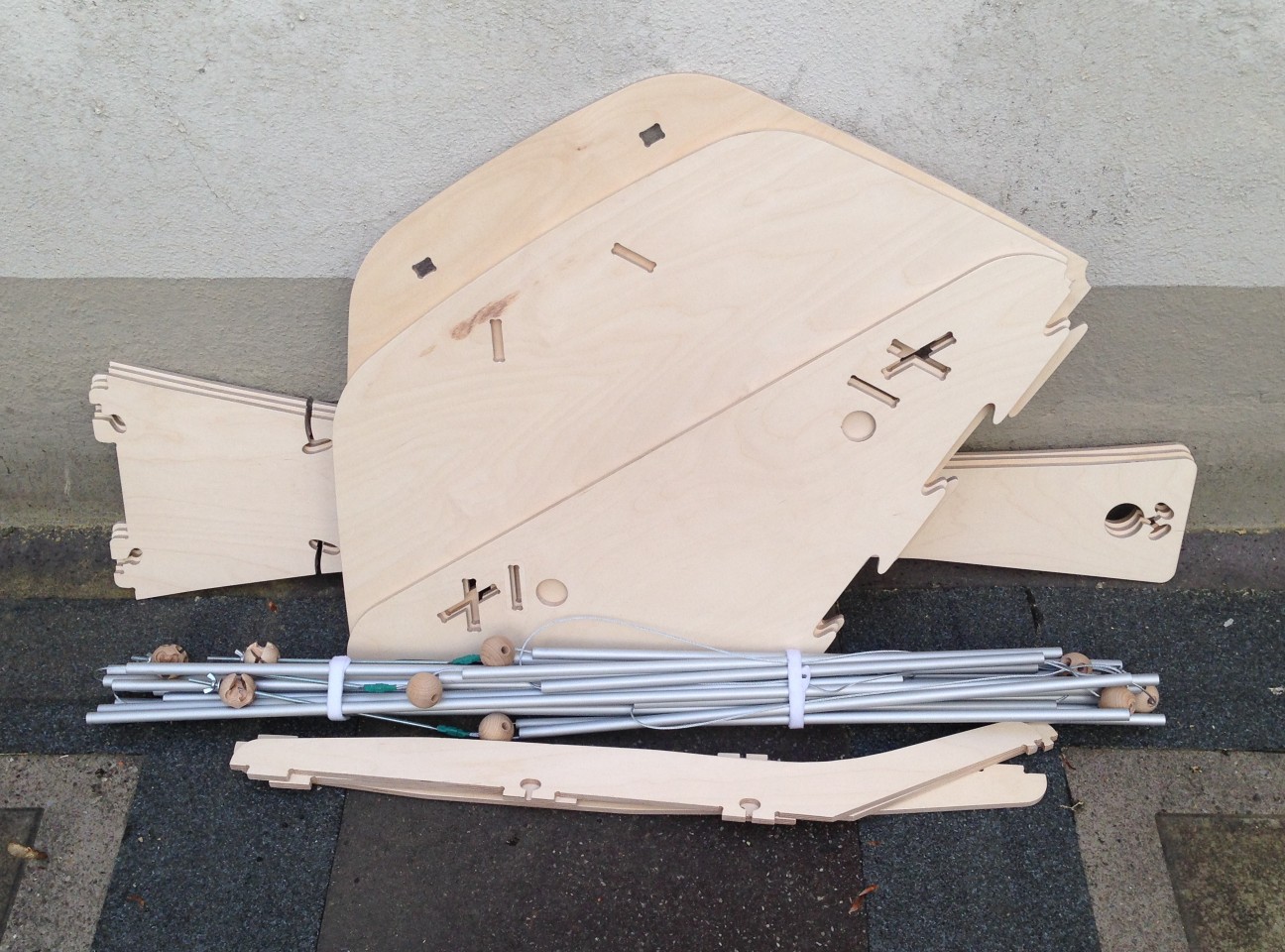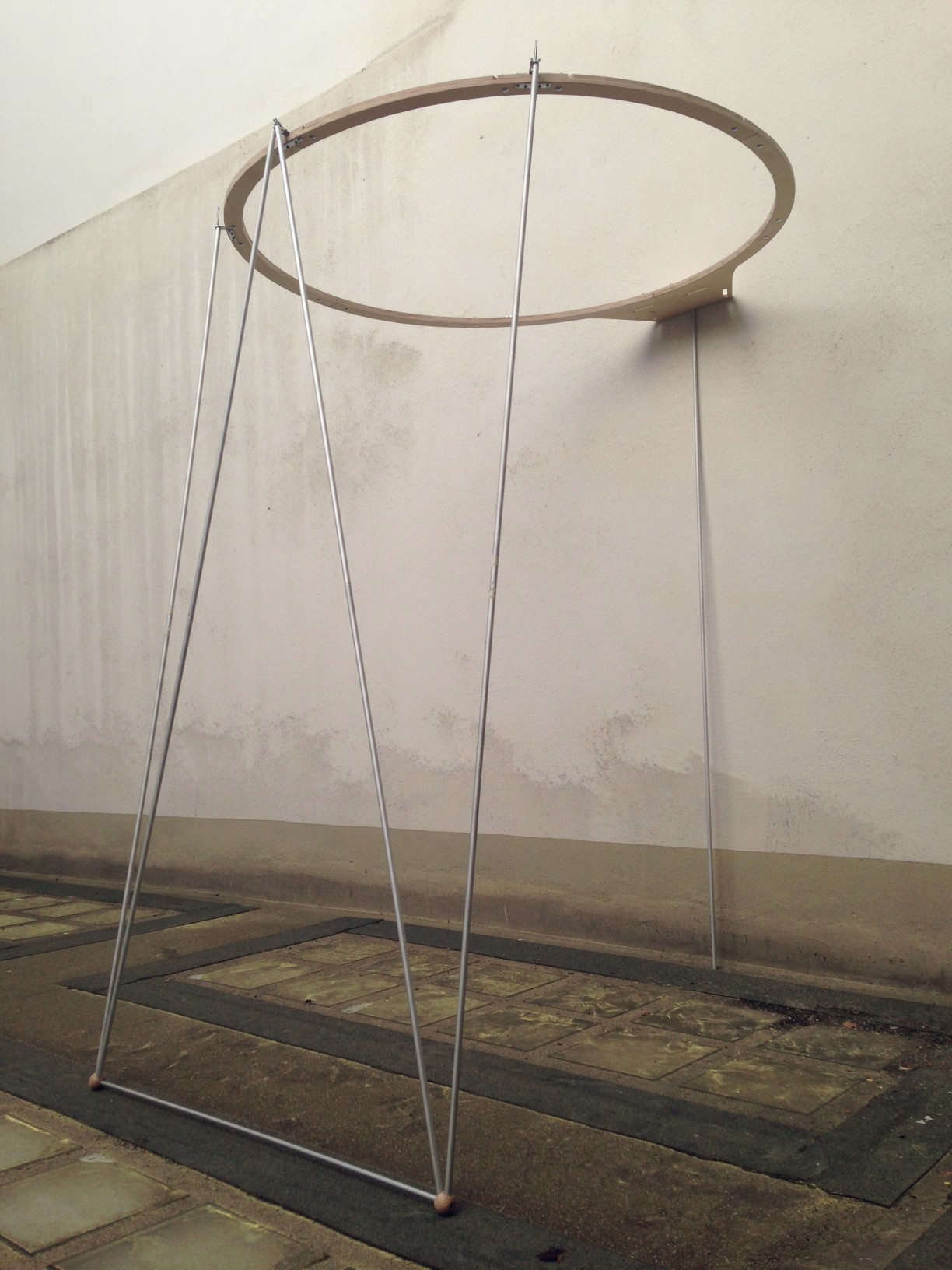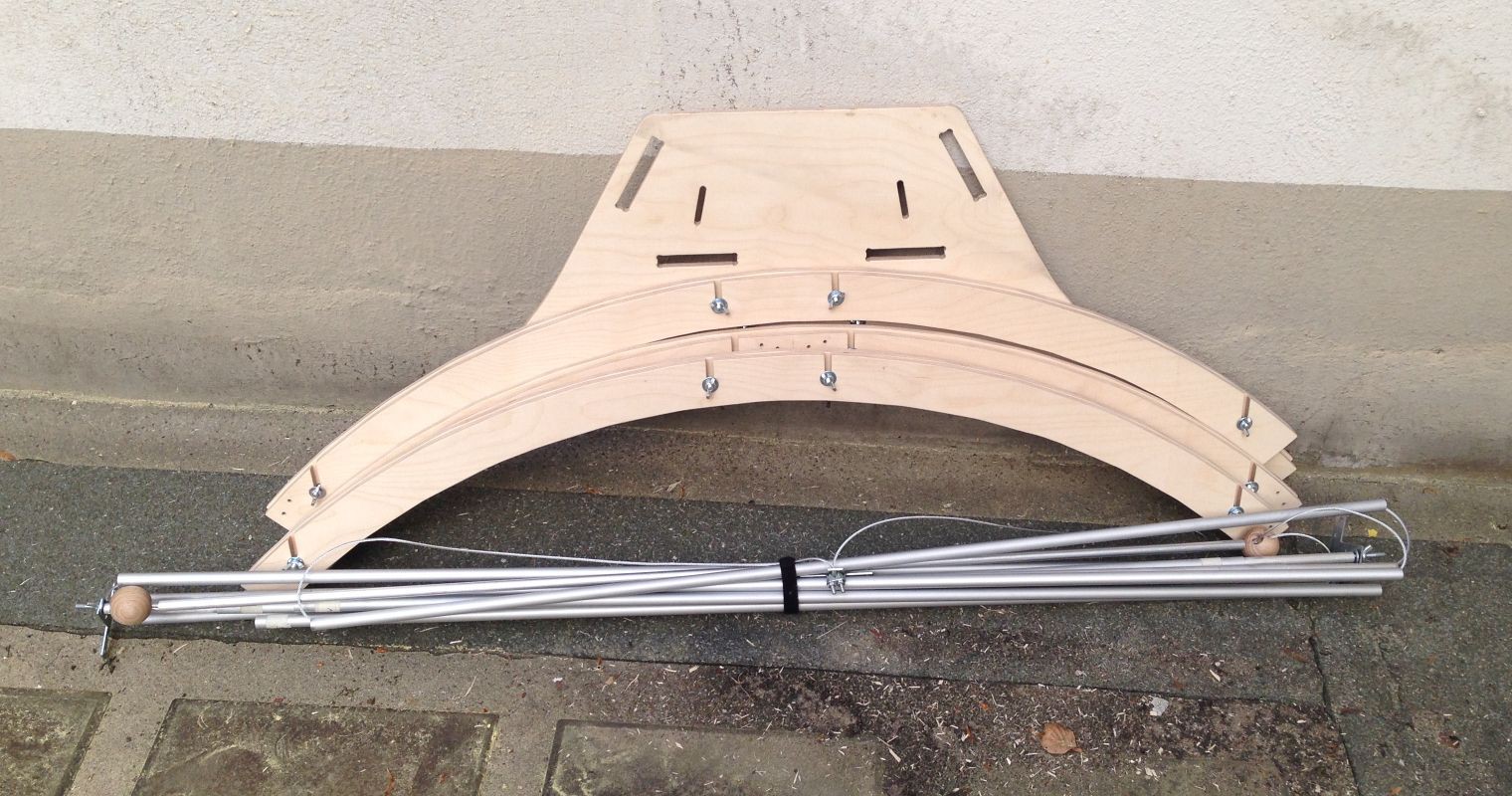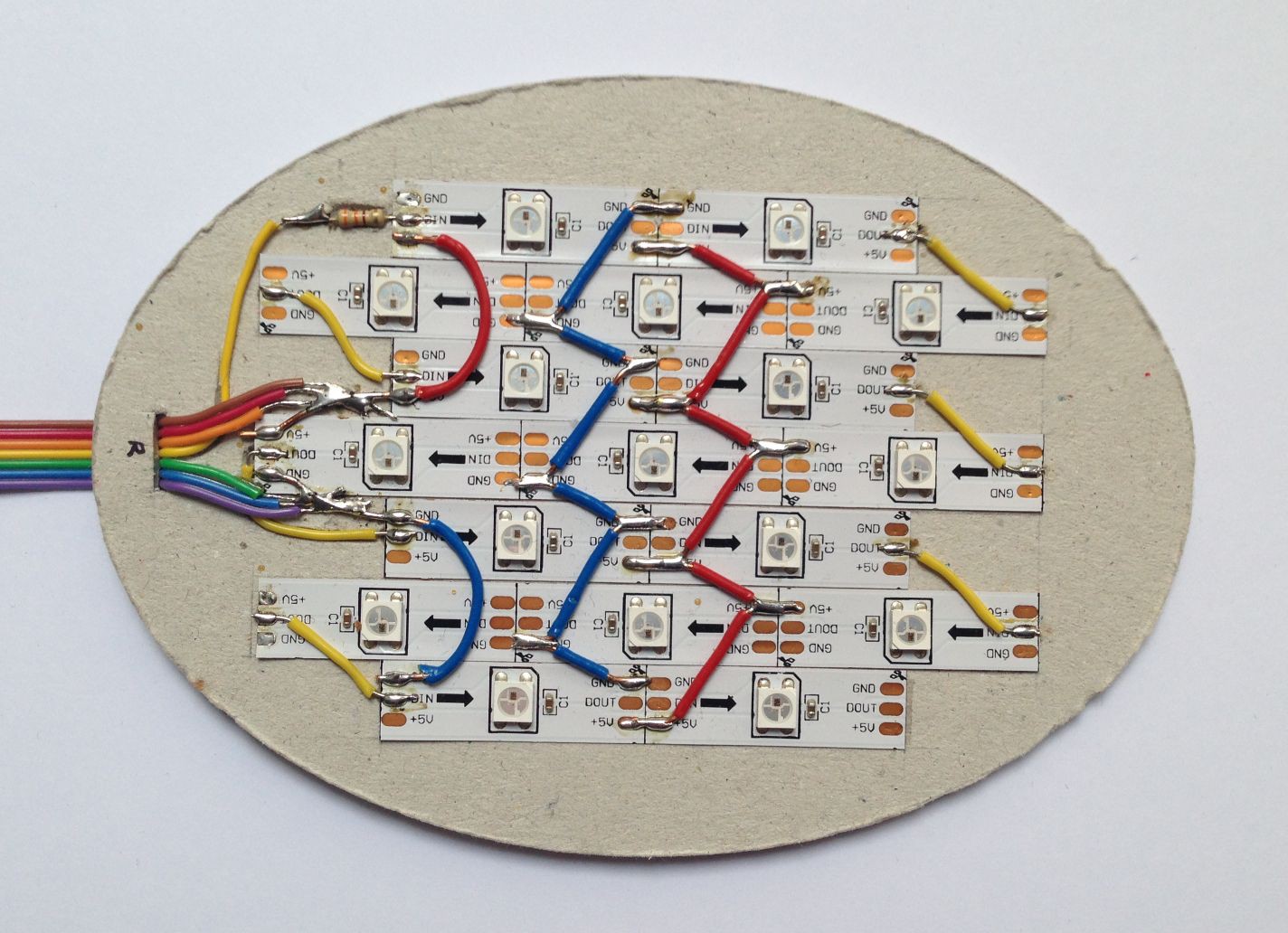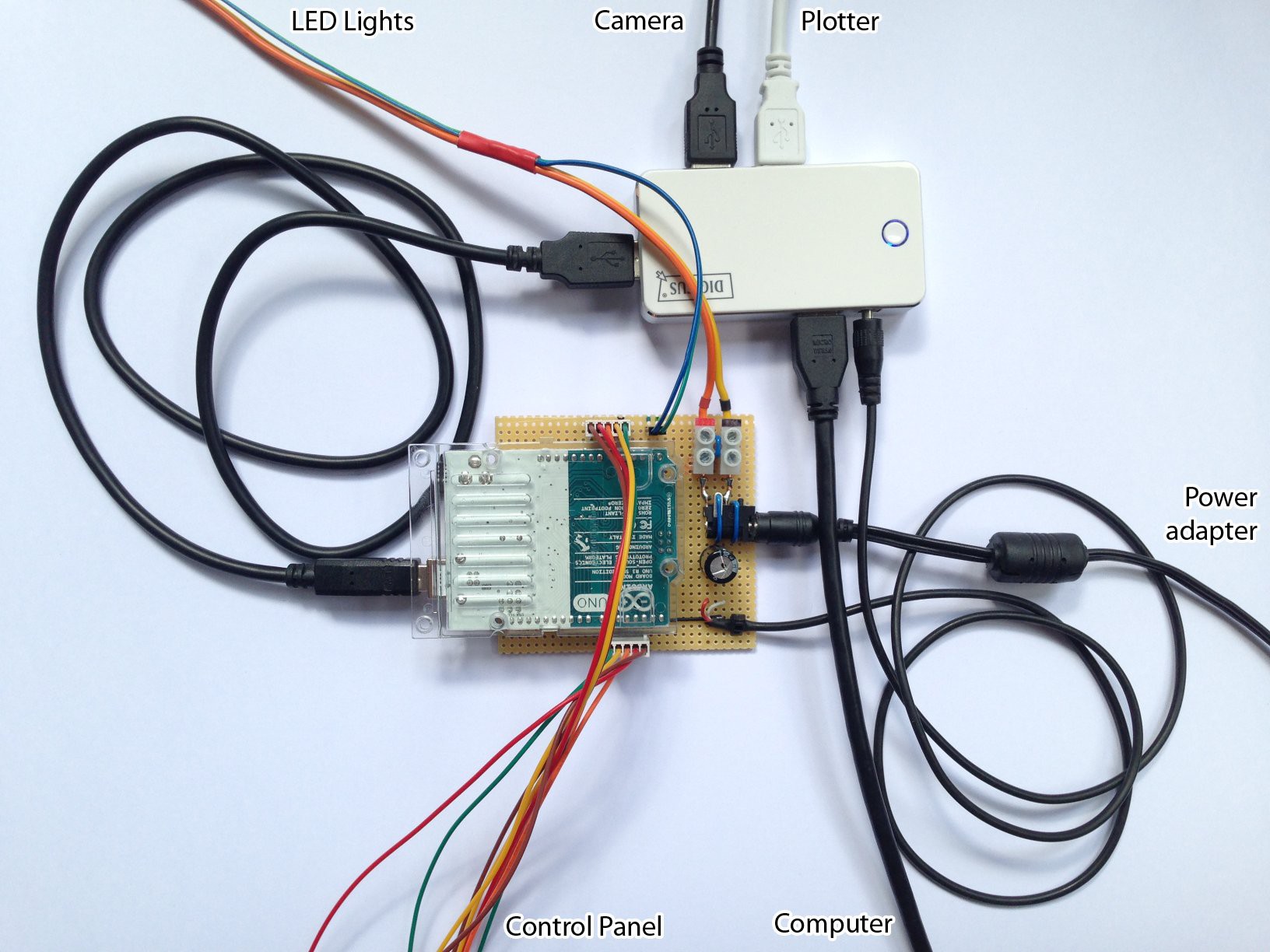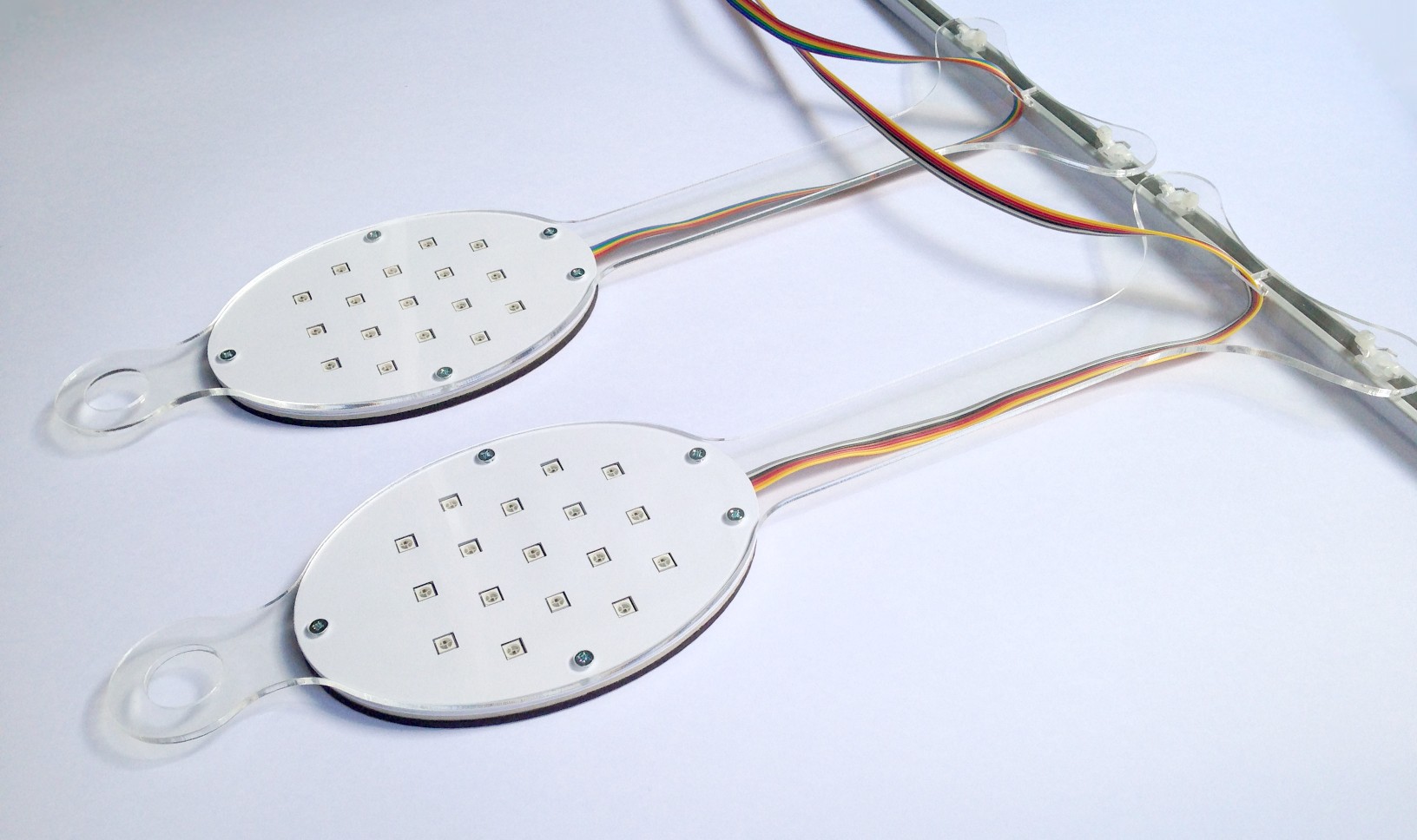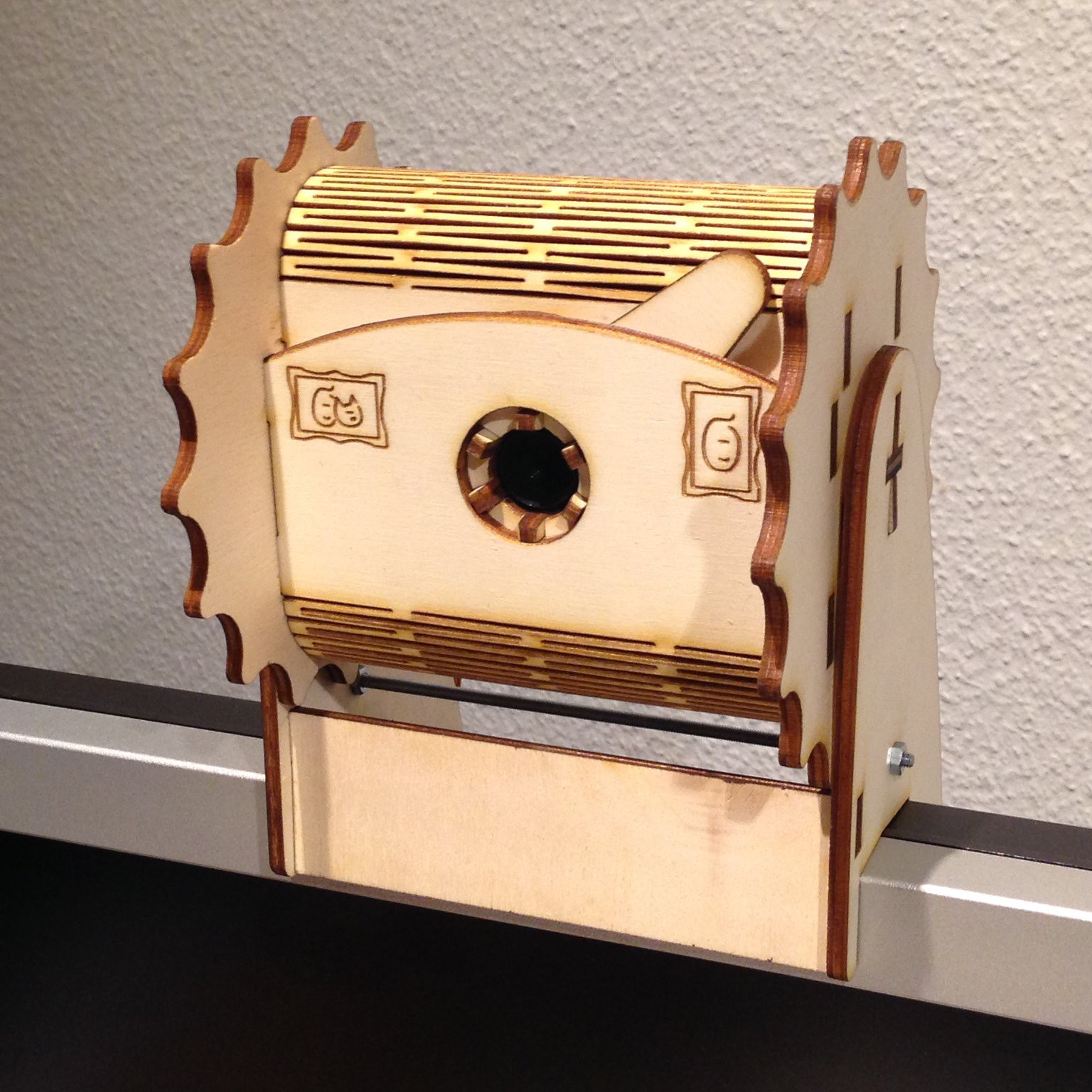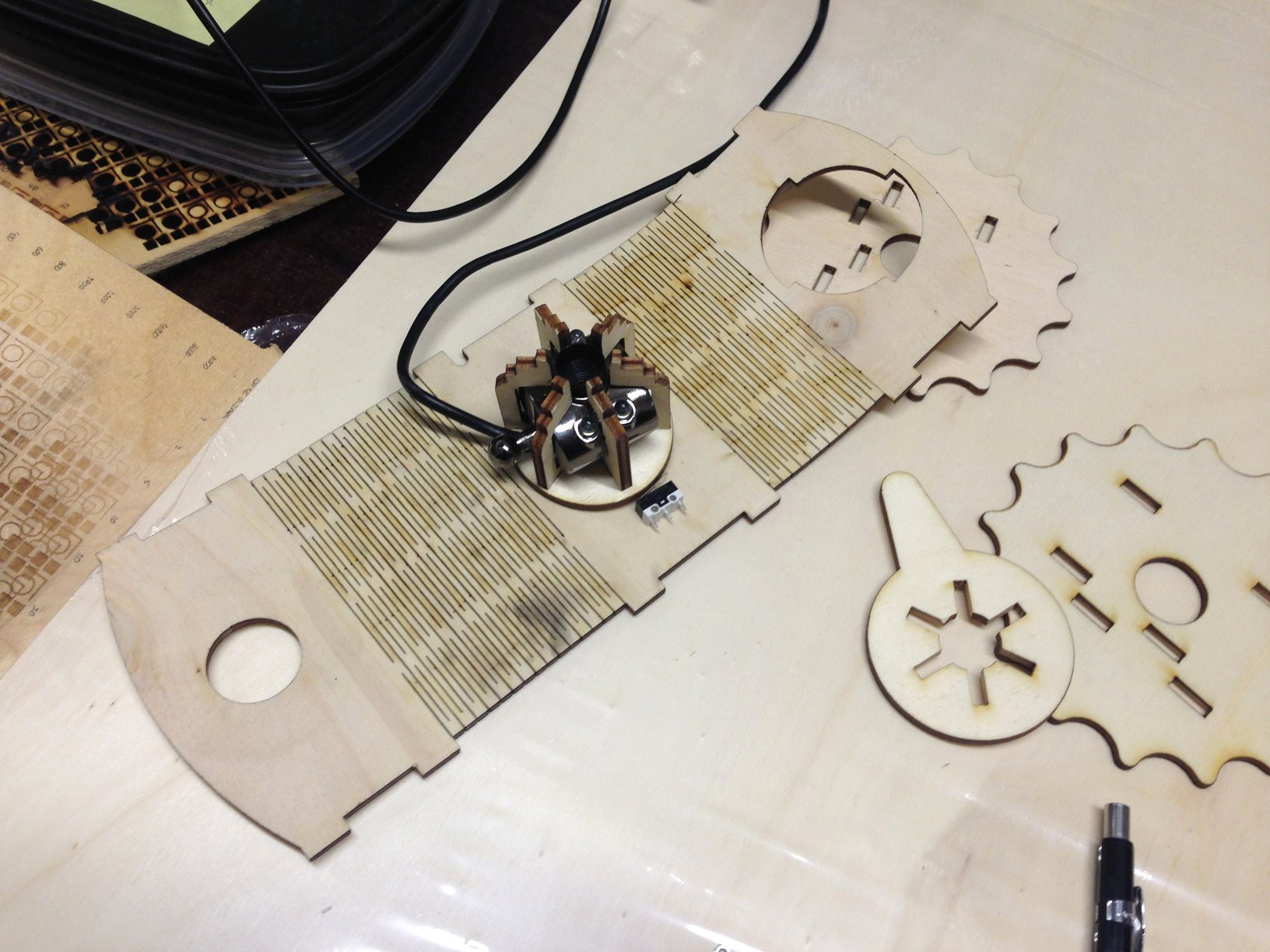-
Exhibition Marathon
10/08/2018 at 10:45 • 0 commentsDuring the last three weeks, I went to three exhibitions with the Portrait Plotter. That was fun, but I’m a bit exhausted now. It also got me some exercise in hauling the whole thing around – it now takes me 3 hours to set up and 2 hours to dismantle.
Maker Faire Zürich was as awesome as every time. I just love the jam-packed creative atmosphere at that event. As usual when exhibiting alone, I couldn’t visit all the talks and exhibits I would have liked to, but seeing visitors playing delightedly with the Portrait Plotter, marble run, and LED panel made up for that. An interview where I talk about my work was published in advance of the event.
![]()
![]()
During the Maker Faire, I was approached and invited by the organizer of Flick the World, a smaller and more improvised festival in Zürich aiming to connect different maker/tinkerer/artist communities, especially also from the field of music and video. That was fun too, and this time I got ample opportunity to interact with other participants and their works. With just five other exhibits, the Portrait Plotter got a prominent place and was kept remarkably busy. The organizer suggested asking for donations rather than a fixed price for a plot, which seems to have worked very well. Total revenue over the two days was a littler lower than at the Maker Faire, but I did get the impression that it increased visitor engagement, reduced a barrier, which is a trade I am happy to make. I therefore plan to stick to that “pay what you want” model for now.
![]()
Last Friday, the Startup Night Winterthur took place at the startup incubator that also hosts FabLab Winti, and the FabLab was also present with a booth among the startups promoting their products and services. As an active member of the FabLab, I was invited to present the Portrait Plotter there as an example of what can be made in a FabLab. That turned out a somewhat special experience, as the audience of such a fair clearly expects companies trying to sell their products, not art installations created by hobbyists. Many visitors showed no interest at all, with others it took some explaining to make clear what the point of this installation was. But I still sold a few plots, had a few nice conversations, and reached some people outside of my usual interest group that I wouldn’t otherwise have reached, so I am not dissatisfied.
Obligatory additions to the to-do list:- One visitor mentioned that there are open-source implementations of the Silhouette protocol, meaning that I may be able to automate more of the plotter driving without having to build my own plotter. A quick search turned up these two: Inkcut, inkscape-silhouette.
- When placed in a dark corner, as desired for the best pictures, the Portrait Plotter almost vanishes from the sight of the audience. I should add a spotlight that illuminates the tower with the example plots and the plotter, without casting too much light into the cabin. At Flick the World, such a spotlight was provided by the venue, and it made a large difference in making the machine stand out and appear attractive.
- It would be nice to be able to recall previous portraits back on the screen when a visitor wants to compare several ones or a previous visitor returns after their portrait has been overwritten by a later visitor.
-
New Control Panel
08/24/2018 at 20:42 • 0 commentsHere is the new control panel that addresses some of the shortcomings mentioned previously:
![]()
It is longer and mounted higher up to make it better reachable, it includes a connector for a foot switch to complement the trigger button, and it features some more knobs to play with: A potentiometer to adjust the red/green choice to the ambient lighting (or just modify it artificially), and two push buttons that exchange the colors in the final image, to give a preview of what it will look like when plotted with different pens. These also light up in the chosen colors. To achieve this, I ripped out their original white LEDs and instead illuminate them from the side with a two-LED piece of NeoPixel strip.
The additional space also allows mounting the Arduino board and the 5V power supply beneath the panel, which reduces the clutter inside the pyramid.
![]()
It is all wired up and the Arduino software written, now I just need to make use of it in the image processing application.
-
Maker Faire Review
06/17/2018 at 12:50 • 0 comments![]()
Maker Faire Bodensee was fun and interesting, but not as overwhelmingly awesome as I had found Maker Faire Zürich in the past two years. Why? I can’t really say myself. While I like having some room to breathe, maybe spreading out over the large exhibition hall somehow diluted the maker spirit, compared to the crammed space in Zürich? What certainly played a role is that there were fewer visitors than I expected. Especially on Sunday, I sometimes spent 15 minutes or so alone at my booth, which was a bit boring.
This also reflected in the revenue from the portrait plotter – 8 portraits sold during the two days, little more than I had sold in three hours at the holiday market. I was hoping that the portrait plotter would pay for the booth rent, but I missed that goal by more than a factor of two. One visitor suggested that I might have sold more at a price of 5 Euros instead of 10. Could be that I had the Swiss price level in mind when I set that price and Germans are more sensitive there, but then the price is arbitrary anyway (as the marginal cost of one portrait is negligible compared to the cost of building the machine) and it does not feel too high to me for a piece of art.
The portrait plotter also appeared to be less of an attraction than I had expected, many people seemed to walk by without taking notice, in spite of its size. Maybe they did not understand what it did, or maybe it was not clear enough that they could try it on their own, without asking, for free? Still, feedback from those who did take notice was very positive, and I had some nice conversations with visitors and other makers. On top of that, I received a Maker of Merit award from the organizers, which was a nice surprise.
Technical insights from this round:- I could not gather much data on the placement of the control panel, but I realized that even if it was moved up and towards the subject as far as the construction reasonably allows, it would still be out of reach for some poses. I am now thinking of adding a handheld trigger button or a foot pedal to complement the button on the panel.
- The lighting in the exhibition hall was so bright that the red and green LED lights hardly made a difference. I covered the top of the ring with black garbage bags, which helped to some extent, but not sufficiently. Also, light from the back was bleeding through the black curtain, making the background not totally black. It seems that some kind of a hood is needed that can be thrown over the whole thing and also covers part of the sides.
- The lighting also had the effect that the image processing algorithm would almost always choose red as the accent color. It was very difficult to obtain a stable green accent, even with both LEDs at full green. I wonder if I should read out the light settings and make them affect the choice. Or just add an adjustable bias.
In summary, I won’t run out of things to improve until Maker Faire Zürich in September, for which I just signed up!
-
Integration Test
05/27/2018 at 14:47 • 0 commentsThis week I made potentiometer knobs for the control panel, bent the curtain rails and mounted them to the cabin ring, and sewed the black curtain. Now, just in time, with less than a week to go until the Maker Faire, I am finally at a stage where all the parts can be assembled for the first time. And everything seems to work! :D
![]()
![]()
Minor issues to be addressed in a later iteration:
- The pyramid topples over a little too easily in the direction of the cabin. This is easily fixed by tying it down with an additional belt, but add some slits to do it more elegantly.
- When the camera is aimed at a tall person like me, its field of view almost goes over the height of the black curtain.
- The proper positions for a nicely sized portrait span the back half of the cabin, which, as I already suspected, makes the control panel a bit too far away and too low to comfortably reach for me. But let’s see at the Faire how it works for shorter people.
-
Tower Part 2
05/21/2018 at 11:42 • 0 commentsWith all the sanding done, here is the pyramid, assembled for the first time.
![]()
![]()
I continue to be impressed with Onshape. Its “edit in context” feature makes it very easy to design such tab-and-slot constructions with arbitrarily arranged parts. Here’s the document again.
-
Monitor and Camera Mount
05/20/2018 at 07:49 • 0 comments![]()
One of three sides of the upper pyramid.
-
Tower Part 1
05/18/2018 at 20:43 • 0 comments![]()
![]()
The “space frame” idea for the tower part turned out feasible, so I went ahead with that one. The space frame construction, made of the same 12 mm aluminum tubes, 2 mm steel cable, and 35 mm hardwood balls as the stand for the cabin part, is rock solid, even by itself. I didn’t dare sitting on it, but I piled about 16 kg of stuff on it and it didn’t budge. I suspect the weakest points are the wooden balls, and I half expect that at some point one of them will burst with a bang. This should not cause too much damage however, as the tubes can’t move very far without them, still being held together by the cable – except in one case with the joints at the bottom center, where there is one piece of cable that is not wrapped around the other ones because there wasn’t space for it inside the ball, so if the ball breaks along that plane, the joint will fall apart into one piece with two tubes and one with four. This can be mitigated by reducing the tension in that direction using an additional belt around the legs.
The wooden legs, which are maybe a bit overdimensioned, as two of them alone turn out to easily hold my weight, are designed to both bear the majority of the load and hold the tubes in place in the event that a ball breaks. All the wooden parts are CNC-routed from 9 mm birch plywood. Their sizes push the limits of the CNC router at FabLab Zürich, which was also the reason why the table is split into three parts (apart from allowing it to be assembled in two mirrored arrangements). Making efficient use of the material is hard when the parts are so large that only one of them will fit into the router at a time, so I now have lots of oddly shaped plywood residuals sitting in my home. I will think of something to build out of them…
On top of the table, a truncated pyramid of three more plywood parts will hold all the components. I routed the last one of them today, but still have lots of rough edges to sand on all of them.
-
Structure Progress
04/28/2018 at 21:09 • 0 commentsThis week I signed up as an exhibitor for Maker Faire Bodensee, with the portrait plotter as my main exhibit. There is not a lot of time remaining until June 2nd/3rd, but I hope to get a somewhat more permanent mechanical structure done by then. The goal is to build something that can stand on its own, but is lightweight and easily disassembled into pieces of about 1 meter in length for transport. Here is how the photo cabin part that will hold the black background curtain and the LED lights is coming along:
![]()
![]()
The stand made of aluminum pipes tightened together with a thin wire rope on the inside turned out a little wobblier that I had hoped for (mainly due to the elasticity of the wooden ring), but it still bears more weight than it needs to, so I am satisfied for now.
For the tower part that will support the other side of the ring and house the monitor, camera, control panel, computer, and plotter, I am still exploring several possibilities.
-
LED Lights
04/24/2018 at 13:36 • 0 comments![]()
This is one of the two LED lights as it was made in December: NeoPixel strips (left over from my LED panel project) mounted on gray cardboard. Power and signal is delivered over a ribbon cable where 3 wires each are connected in parallel for the power lines, empirically determined for an acceptable voltage drop at maximum current. Some of the red and blue power wires between the strips are redundant in order to get a more even voltage distribution under load, however I did not measure whether that was actually needed.
The LEDs, among other things, are controlled by an Arduino Uno that is also connected to the computer by USB-serial. I would normally use something smaller, but I had a couple of these lying around. The Arduino does all the interfacing between the computer and the various electronic parts:- It reads two potentiometers on the control panel and drives the LED lights, smoothly fading from black to red to green to black to white as the knob is turned. Because the NeoPixels are individually addressable, I could also display patterns, but I don’t do that at the moment.
- It reads the trigger button (a 60 mm white illuminated arcade button) and tells the image processing software when it is pressed.
- It controls the illumination of the trigger button, switching between three different patterns as told by the image processing software: Steady light while the camera is continuously capturing, pulsing when the trigger was pushed, the image is frozen and the line drawing is being generated, and blinking when generation is finished.
![]()
There are conflicting opinions on whether it is safe to power an Arduino Uno through its 5V pin while it is also connected to a computer by USB, so what I did was instead power it by USB from a powered USB hub, which in turn is powered from the 5V power adapter that also powers the LED lights. This way, the hub takes care of not feeding power back into the computer.
![]()
Now, for the final setup, I enclosed the LED lights in a sandwich of more cardboard and paper parts with cutouts for the internal components (cut on the Curio), an MDF back plate, and an acrylic front plate (lasercut). With the neck of the acrylic part, the lights are hung from a circular curtain rail that allows them to be moved 360° around the subject.
-
Camera Housing
03/24/2018 at 23:25 • 0 commentsI still owe you some posts about the December hardware, but in the meantime here’s what I made today:
![]()
A camera housing with an adjustable vertical angle and a lever that rotates the camera by 90° to switch between portrait and landscape orientation. It contains a switch that detects the orientation and will tell it to the software via the Arduino. All held together by a single bolt, no glue.
![]()
The 4 mm (actually, 3.75 mm) poplar plywood turns out to be a bit too brittle for the stressed moving parts, one of them broke already – maybe I’ll try redoing them in MDF. But for now it’s working.
Onshape’s sheet metal tools turn out useful for the bent plywood parts – you design them in 3D and it automatically lays them flat. Only the slit pattern for the bends was added by hand in Illustrator. (Here’s the document if you want to take a peek.)
Portrait Plotter
An interactive installation that takes your photo and paints it on paper.
 Christian Walther
Christian Walther
